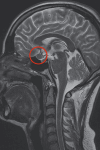Reconstructive Liposuction for Residual Lipodystrophy After Remission of Cushing's Disease: A Case Report
- PMID: 40718312
- PMCID: PMC12296909
- DOI: 10.7759/cureus.86794
Reconstructive Liposuction for Residual Lipodystrophy After Remission of Cushing's Disease: A Case Report
Abstract
Cushing's syndrome (CS) is often presented due to an adrenocorticotropic hormone (ACTH)-secreting pituitary adenoma, characterized by high chronic cortisol levels. Surgical resection of the pituitary adenoma is the primary treatment, but long-term metabolic and physical sequelae can persist, affecting psychological well-being and social functioning. Glucocorticoids are directly involved in alterations of fat metabolism, favoring centripetal adiposity. Even after hormonal normalization, patients may experience residual lipodystrophy. Impairment of body image may cause psychological distress and social isolation. The objective is to illustrate the potential therapeutic value of reconstructive liposuction in restoring body image and psychological well-being in a patient with persistent lipodystrophy after Cushing's disease remission. We report a case of a 16-year-old female with recurrent Cushing's disease secondary to a pituitary microadenoma, confirmed by elevated urinary free cortisol and magnetic resonance imaging (MRI). It was initially treated with transsphenoidal resection in 2019; disease recurrence was confirmed and again treated in 2024. Despite intervention, the prolonged hypercortisolism developed into secondary lipodystrophy, leading to severe body image dissatisfaction and social withdrawal. Thyroid function remained euthyroid, ruling out metabolic contributors. Because of the psychological distress caused by persistent fat redistribution, the patient underwent elective liposuction in 2025. Postoperative follow-up revealed reduced psychological distress and improved well-being and self-esteem. Reconstructive liposuction can play a key role in the treatment and management of persistent post-CS lipodystrophy, contributing significantly to psychological recovery. Prospective studies evaluating surgical criteria and long-term psychosocial outcomes are needed to define eligibility criteria and assess outcomes, leading to the development of clinical guidelines for aesthetic interventions in post-CS recovery.
Keywords: acth-secreting pituitary adenoma; cushing’s syndrome; lipodystrophy; liposuction; psychological burden; social functioning.
Copyright © 2025, Mondragón Rosas et al.
Conflict of interest statement
Human subjects: Informed consent for treatment and open access publication was obtained or waived by all participants in this study. Conflicts of interest: In compliance with the ICMJE uniform disclosure form, all authors declare the following: Payment/services info: All authors have declared that no financial support was received from any organization for the submitted work. Financial relationships: All authors have declared that they have no financial relationships at present or within the previous three years with any organizations that might have an interest in the submitted work. Other relationships: All authors have declared that there are no other relationships or activities that could appear to have influenced the submitted work.
Figures


Similar articles
-
Outcomes of the Transsphenoidal Approach for ACTH-Secreting Pituitary Tumours and the Role of Postoperative ACTH in Predicting the Late Recurrence of Cushing's Disease: A Retrospective Analysis of 50 Cases.Healthcare (Basel). 2025 Jun 11;13(12):1395. doi: 10.3390/healthcare13121395. Healthcare (Basel). 2025. PMID: 40565420 Free PMC article.
-
Cushing's disease: current medical therapies and molecular insights guiding future therapies.Neurosurg Focus. 2015 Feb;38(2):E11. doi: 10.3171/2014.10.FOCUS14700. Neurosurg Focus. 2015. PMID: 25639313
-
Emerging diagnostic methods and imaging modalities in cushing's syndrome.Front Endocrinol (Lausanne). 2023 Jul 25;14:1230447. doi: 10.3389/fendo.2023.1230447. eCollection 2023. Front Endocrinol (Lausanne). 2023. PMID: 37560300 Free PMC article. Review.
-
Clinical Utility of Osilodrostat in Cushing's Disease: Review of Currently Available Literature.Drug Des Devel Ther. 2023 Apr 27;17:1303-1312. doi: 10.2147/DDDT.S315359. eCollection 2023. Drug Des Devel Ther. 2023. PMID: 37143705 Free PMC article. Review.
-
Ectopic ACTH-secreting pituitary adenoma of the sphenoid sinus: case report of endoscopic endonasal resection and systematic review of the literature.Neurosurg Focus. 2015 Feb;38(2):E10. doi: 10.3171/2014.10.FOCUS14685. Neurosurg Focus. 2015. PMID: 25639312
References
-
- Tatsi C. Endotext [Internet] South Dartmouth (MA): MDText.com, Inc.; 2000. Cushing syndrome/disease in children and adolescents.
-
- Adipose tissue in cortisol excess: what Cushing’s syndrome can teach us? Bavaresco A, Mazzeo P, Lazzara M, Barbot M. Biochem Pharmacol. 2024;223:116137. - PubMed
Publication types
LinkOut - more resources
Full Text Sources
